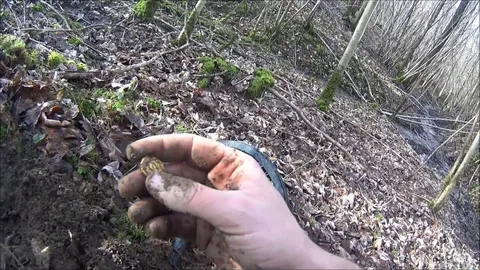US Gold Mining: The Current State and Future Prospects
US gold mining has been a significant industry for centuries, with the first gold discovery in the country dating back to the early 19th century. The industry has seen fluctuations in production and profitability over the years, impacted by various factors such as market demand, technological advancements, and regulatory changes. In recent years, US gold mining has faced both challenges and opportunities, leading to a shift in the current state of the industry and potential future prospects. This article will explore the current state of US gold mining, including production levels, key players, and market trends, while also examining the potential future prospects for the industry.
US Gold Mining is currently facing several challenges, including declining reserves, increasing environmental regulations, and fluctuating gold prices. Many of the major gold mines in the United States have been in operation for decades and are nearing the end of their productive lives.
Furthermore, environmental concerns and community opposition have made it increasingly difficult for new mining projects to get off the ground. Additionally, the volatility of gold prices has made it challenging for companies to plan and invest in new mining operations.
However, despite these challenges, there are still opportunities for growth in the US gold mining industry. Advancements in technology and mining techniques could potentially make it more economical to extract gold from lower-grade ores. Additionally, the growing demand for gold, particularly in emerging markets, could drive future investment in US gold mining projects.
Overall, the future prospects of US Gold Mining will depend on the industry’s ability to adapt to changing market conditions, technological advancements, and environmental regulations. While there are challenges to overcome, there are also opportunities for growth and development in the industry.
Exploring the History of US Gold Mining

Exploring the history of US gold mining can provide valuable insights into the development and impact of this industry on American economy and society. Gold mining has played a significant role in shaping the growth and expansion of the United States, from the California Gold Rush in the mid-19th century to the development of large-scale mining operations in Nevada and Alaska. Understanding the historical context of US gold mining can also shed light on issues such as labor rights, environmental impact, and the legacy of mining communities. By examining the history of US gold mining, researchers and enthusiasts can gain a deeper understanding of the complexities and consequences of this industry.
The Environmental Impact of US Gold Mining Operations

Gold mining in the US has significant environmental impacts, including the release of pollutants such as mercury and cyanide, deforestation, habitat destruction, and the disruption of local ecosystems. The extraction and processing of gold also require large amounts of water, leading to water scarcity and contamination.
Additionally, the use of heavy machinery and explosives in mining operations can lead to soil erosion and land degradation. The disposal of waste rock and tailings can result in the release of toxic substances into the environment, posing risks to nearby communities and wildlife.
Furthermore, the carbon footprint of gold mining operations is considerable, with emissions from diesel-powered machinery, electricity use, and transportation contributing to climate change. The construction of infrastructure such as roads and power lines for mining activities can further fragment natural habitats and contribute to biodiversity loss.
Overall, the environmental impact of US gold mining operations underscores the need for sustainable practices and stringent regulations to mitigate harm to the environment and local communities. Efforts to minimize pollution, conserve water, restore ecosystems, and promote reclamation and remediation of mining sites are essential to address the environmental footprint of gold mining activities.
The Future of US Gold Mining: Challenges and Opportunities

The future of US gold mining faces a number of challenges and opportunities. On one hand, the rising costs of extracting gold, stricter environmental regulations, and community resistance are putting pressure on the industry. On the other hand, advancements in technology, the potential for new discoveries, and the increasing demand for gold worldwide present opportunities for the industry to thrive.
One of the main challenges for US gold mining is the declining ore grades, which means that companies have to extract and process more rock to produce the same amount of gold. This leads to increased costs and environmental impacts. Additionally, stricter regulations around water usage, waste disposal, and ecosystem protection are forcing companies to invest in more sustainable and efficient practices, which can be a significant financial burden.
Community resistance to new mining projects is also a major challenge for the industry. Many local communities and indigenous groups are concerned about the environmental and social impacts of mining, and are actively opposing new projects. This adds another layer of complexity to the permitting and development process.
However, there are also significant opportunities for US gold mining. The development and implementation of new technologies, such as autonomous vehicles, drones, and advanced exploration methods, can help companies reduce costs and improve efficiency. These technologies also have the potential to make previously uneconomic deposits viable for mining.
Furthermore, the increasing demand for gold, particularly in emerging markets such as China and India, presents an opportunity for US gold mining companies to expand their operations and access new markets. Additionally, the potential for new discoveries in underexplored areas of the country could provide a much-needed boost to the industry.
In conclusion, the future of US gold mining is predicated on the industry’s ability to navigate the challenges it faces while taking advantage of the opportunities available. This will require a concerted effort from companies, regulators, and communities to find a balance between economic development and environmental and social responsibility.
Top 10 US Gold Mining Companies Making a Global Impact

1. Newmont Corporation: This company is the world’s largest gold producer and operates mines in North America, South America, Australia, and Africa.
2. Barrick Gold Corporation: With operations in the United States, Canada, and around the world, Barrick Gold is one of the largest gold mining companies globally.
3. Kinross Gold Corporation: Kinross operates mines in the United States, Brazil, Russia, and West Africa, contributing to its global impact as a significant gold producer.
4. Freeport-McMoRan Inc.: In addition to its extensive copper mining operations, Freeport-McMoRan also operates gold mines in the United States and around the world.
5. New Gold Inc.: This company has operations in the United States, Canada, and Mexico, and is focused on responsible and sustainable mining practices.
6. Alamos Gold Inc.: With mines in North America and Turkey, Alamos Gold is a significant producer with a global presence in the gold mining industry.
7. Hecla Mining Company: Operating primarily in the United States and Canada, Hecla Mining is a leading silver and gold producer.
8. Caledonia Mining Corporation: This company operates the Blanket Mine in Zimbabwe and has a significant impact on the global gold mining industry.
9. Kirkland Lake Gold Ltd.: With operations in Canada and Australia, Kirkland Lake Gold is a growing gold mining company making a global impact.
10. Coeur Mining, Inc.: Coeur Mining operates silver and gold mines in the United States, providing significant contributions to the global gold mining industry.
Investing in US Gold Mining: A Beginner’s Guide
Investing in US gold mining can be a profitable venture for beginners, as gold continues to be a valuable and sought-after commodity. Before getting started, it’s important to conduct thorough research on different gold mining companies and the current state of the industry. Consider factors such as the company’s financial stability, potential for growth, and the state of the gold market. It’s also important to be aware of the potential risks and volatility associated with investing in the mining industry. Additionally, consider seeking advice from financial experts or experienced investors to gain further insights before making any investment decisions.
The Role of Technology in Modern US Gold Mining
See also: gold prospecting tools
The role of technology in modern US gold mining has become increasingly important in recent years. Advances in drilling and exploration techniques, automation, and data analytics have helped streamline the mining process, making it more efficient and cost-effective. Additionally, technology has played a key role in ensuring the safety of miners by providing real-time monitoring and control of mining operations. Furthermore, environmental concerns have spurred the development of cleaner, more sustainable mining practices, and technology has played a crucial role in implementing and monitoring these initiatives. Overall, technology has revolutionized the gold mining industry in the US, making it more productive, safer, and environmentally friendly.
Regulations and Compliance in the US Gold Mining Industry
The US gold mining industry is subject to a range of federal, state, and local regulations and compliance requirements. These include environmental regulations related to water and air quality, as well as rules governing the disposal of waste materials and the reclamation of land after mining activities have ceased. Companies involved in gold mining must also comply with safety and health regulations to protect their workers. In addition to these regulations, there are also permitting and reporting requirements that companies must adhere to in order to operate legally. Non-compliance with these regulations can result in fines, penalties, and legal action, making it essential for companies to stay abreast of current requirements and ensure their operations are in compliance.
The Economic Benefits of US Gold Mining to Local Communities
The economic benefits of US gold mining to local communities are significant. Gold mining contributes to local economies through job creation, infrastructure development, and business opportunities. It also generates tax revenue that can be used to fund schools, public services, and other community resources. Additionally, gold mining can stimulate other industries such as manufacturing and services, as well as promote economic growth in the region. Overall, the presence of a gold mine in a community can have a positive impact on the local economy and contribute to its overall prosperity.
Exploring the Potential of Untapped Gold Deposits in the US
One of the focuses of mining industry in the US is to explore untapped gold deposits in order to meet the demand for gold. There are various potential areas in the US that are believed to have untapped gold reserves, and mining companies are investing in exploration and development projects in these areas. Additionally, advancements in mining technology and techniques are making it possible to extract gold from previously uneconomic deposits. The exploration and development of untapped gold deposits can not only contribute to the economy but also create job opportunities and support local communities.
Sustainable Practices in US Gold Mining: Balancing Profit and Conservation
Sustainable practices in US gold mining involve achieving a balance between profitable operations and conservation efforts. This can include implementing responsible mining techniques to minimize environmental impact, such as reclamation of mining sites and reducing water and energy consumption. Additionally, ensuring the welfare and safety of workers, as well as engaging with local communities and stakeholders, are important aspects of sustainable gold mining practices. Furthermore, some companies are also exploring the use of alternative technologies and investing in research and development to further advance sustainable mining practices.












